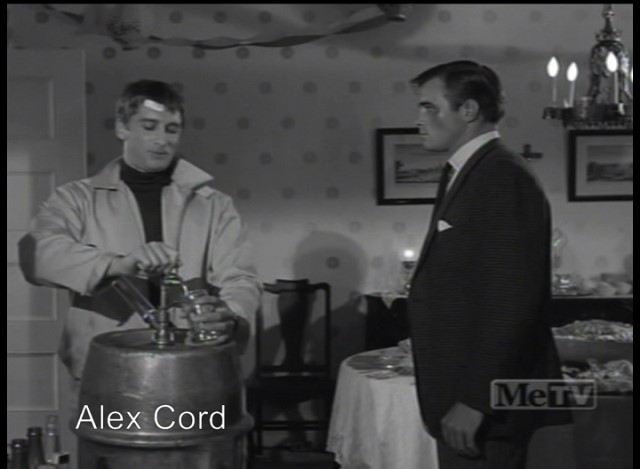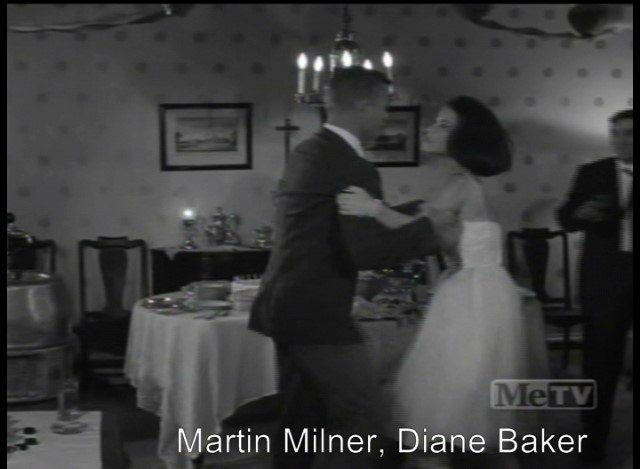
As the fighting breaks out, Tod (Martin Milner) realizes it's all Marie's (Diane Baker)
fault, so he grabs her in preparation for spanking her.
|
This was our reaction to the scene when Chross first posted it:
"I've never seen Martin Milner look so assertive! I remember the series - second-rate drama about
two guys cruising around the country in a great-looking Corvette - but must never have seen this spanking
episode. Now that you've identified it for us, perhaps we'll be able to find a better recording. It
seems to be a rather good scene, unusual in the bending-over position and leisurely pace of the swats."
Martin Milner actually made a very good spanker - he was good-looking in a boy-next-door sort of way,
and a nice enough guy to possess the necessary moral authority to determine when a girl really deserved
a spanking. Between Route 66 and Adam-12, he must have logged more miles behind the wheel
on film than any other actor in history. Baker did well too - she puts back her hands at one point to
try to protect her bottom, without any success of course.
|
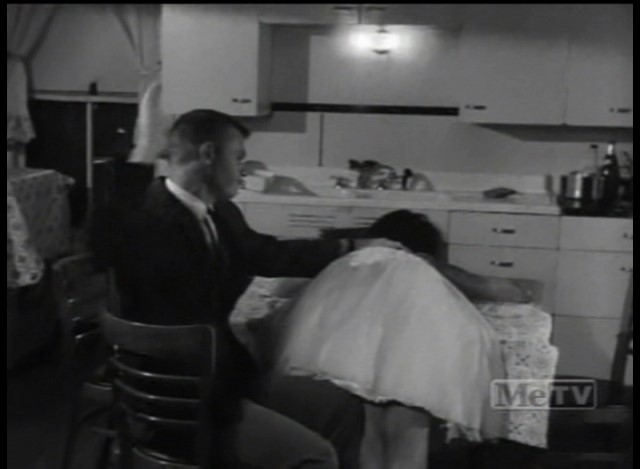
Hauling Marie into the kitchen, Tod bends her over the kitchen table and gives her the first of three good
hard whacks!
|
It's possible that Diane Baker was not too thrilled with the camera angle for the spanking, since she
was aimed fanny-first toward the lens, but we like it well enough. Why didn't Milner just take her
over his knee? It seems to us that there simply wasn't enough room in the kitchen to allow this
without rearranging the furniture (and note that the kitchen and living room were located
in an actual house rather than being a constructed set, so with the cameras and lights in there it
must have been pretty crowded).
Milner lands three solid whacks, so overall this must be considered a pretty good spanking scene,
perhaps unique in that it's a disciplinary spanking given on the spankee's birthday. But in viewing it,
the average person would probably ask "Why did Marie act that way, playing up to Jack and causing
all this trouble?"
|
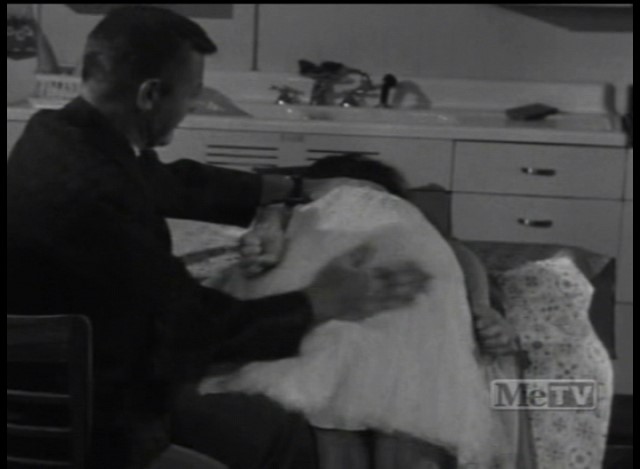
Milner and Baker acted this scene well - she puts her hands back in a futile gesture as he lays the swats
on fairly hard.
|
That turns out to be a hard question to answer. "I'm going to hurt your friend," Marie tells Tod
in the first scene. Tod isn't buying her half-assed rationalizations, that ever since she was
young, she became what others wanted her to be, blah blah blah... - and good for him! Like
everying else in this episode - in fact, in this series - her motivations are both unclear and
unconvincing. We could present this whole scene, or indeed this whole episode in its entirety, and
the viewer would still be left with nothing but psychobabble and third-hand Freudian analysis instead
of any real knowledge of who this character is or why we should care about her.
Ditto for Jack, the sailor. There's nothing that would explain, much less excuse, Jack's pursuit of
Marie or Marie's ready acquiescence - in a way, she takes the lead by stealing Tod's keys and bidding
Jack to follow her (as seen in the spanking scene above). In the end, Marie is neither sexually
repressed nor promiscuous: she and Jack wind up on a beach late at night, and after some more
necking and meaningless self-revelations, Jack urges her to "Come out, come out wherever you are"
(from whence came this episode's title), and she tells Jack, "I don't know what you
want me to be." The two don't make love; Jack returns to his ship and she eventually goes home.
Basically, she's a cipher, and the fault is with the writing - in fact, the series' whole approach
to drama was wrong.
|
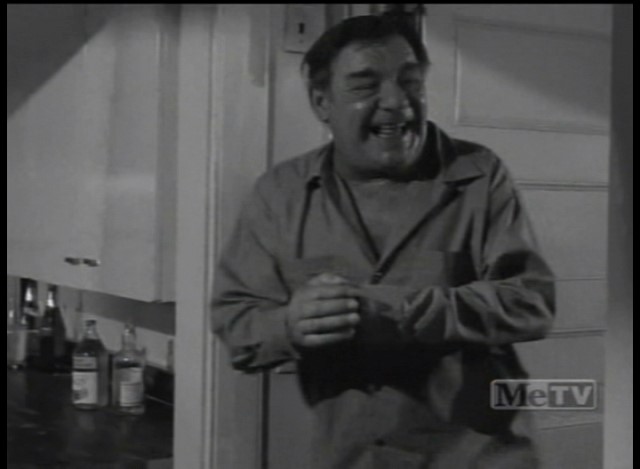
Lon Chaney, a very fine actor, was given so little playable dialogue as Papa
that to cover this fact he spent as much time laughing as Cesar Romero did as the Joker on the
old Batman series. It was the best anyone could have done with the role, but we really felt
sorry for him. Although he played many parts during a long career, young people today would probably
only know him from his roles in various Universal horror pictures such as The Wolf Man in 1941
(see inset at right).
|
You can't create a character by merely grafting some physical or psychological abnormality onto him,
as here with Papa's loss of a hand which was probably intended to signify his distraction by
Marie's mother, or with Marie's own self-confessed lack of identity. But none of their speeches give us
any real insight into their characters; Lon Chaney's
occasional sad glances are as close as we come, and he's forced into almost continual laughter to
disguise the absence of any meaningful dialogue. If all this sounds confusing, believe us when we
say it doesn't make any more sense when you've gone over the entire thing twice as we have. And
this was typical of the series: each week there would be another oddball "character" who lacked
any real depth.
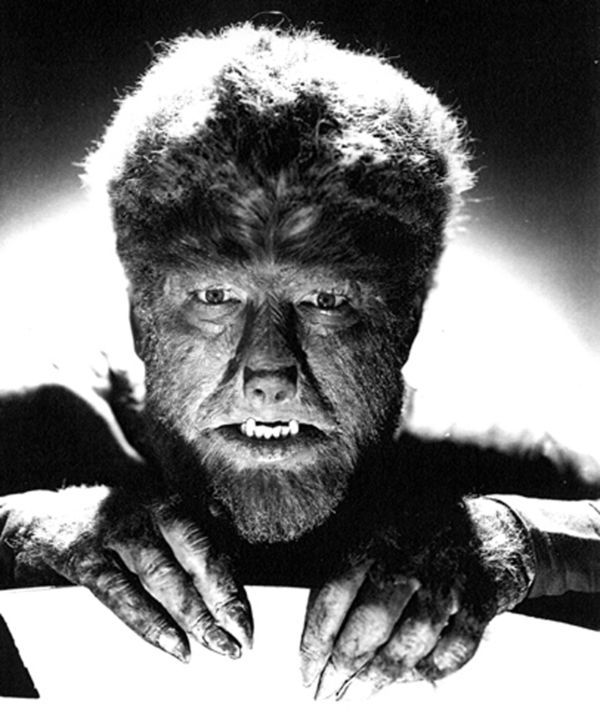
|
|
|
Two things in particular undermined the drama on Route 66: its reliance on naturalism and the
crushing time pressure on Stirling Silliphant, who acted as a sort of head writer while also
producing the show. He had to spend a lot of time scouting locations, leaving him very little time to
do any real writing. Silliphant was listed as co-scripter on this episode with Anthony Basta
(over a story by Richard Jessup), but we'd guess the spanking was Jessup's idea and Silliphant
mainly did some touch-up work on the script.
Route 66 had a very unusual opening: instead of a fixed sequence perhaps including
still shots accompanied
by theme music over which the starring credits would roll (think Mission: Impossible or most
any other series in the 60's), Route 66 would start the story right away, using anything from
establishing shots to close-ups, with the opening credits worked in wherever possible. Even the theme
music had to be worked in, with a new transition and often a new arrangement every week, requiring
considerable effort from composer Nelson Riddle. The remaining credits (writer, director)
would appear at the beginning of the second scene, which was common practice. At left is the
opening sequence from "Come Out, Come Out, Wherever You Are".
The player at left should work with most browsers, or you can download the
Windows Media (WMV) version here. No MPEG-2 version is
being provided, since we don't imagine anyone is interested in burning the opening sequence to DVD.
To download, right-click and then select "Save Target As".
|
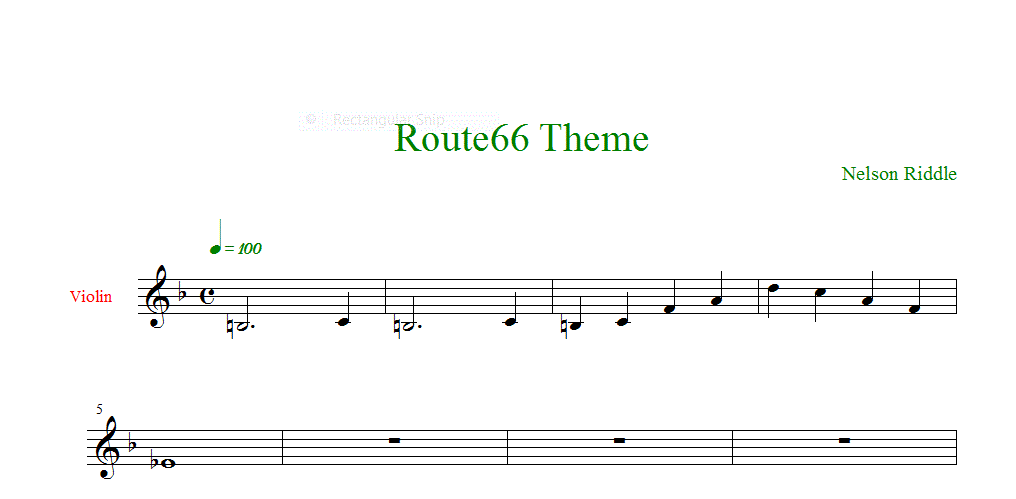
|
We mentioned that Nelson Riddle had to work the theme into the opening sequence. In this
episode's opening, which begins with the least action possible (Tod and Linc are asleep), Riddle
used the traditional French melody Frère Jacques (Are You Sleeping?) and then transitioned to
a quiet statement of the Route 66 theme. For the benefit of CSR readers who may be musically
inclined, we have notated the theme at left (click to enlarge).
|
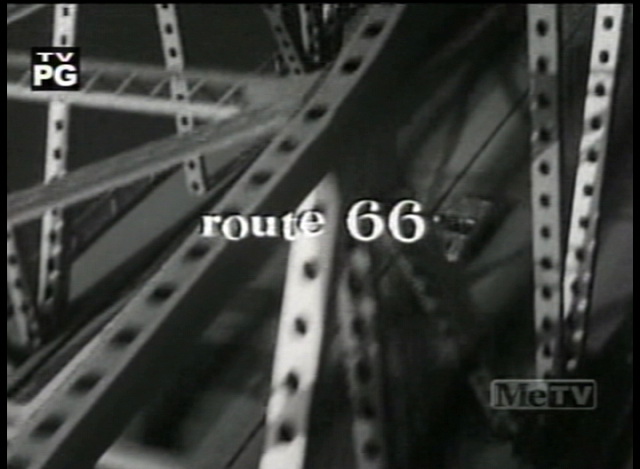
The opening sequence from "Give the Old Cat a Tender Mouse," a helicopter shot of Tod's Corvette
entering Memphis, Tennessee.
|
Now the basic premise
of the series was that two friends go driving across the country (on Route 66, sort of). But if it
was to be an odyssey of self-discovery, the problem was that no discernible character development
ever took place among the principals (Martin Milner, George Maharis, and later Glenn Corbett when
Maharis developed severe back trouble), nor did they ever seem to "find themselves" if that's what
they were trying to do. On the other hand, when the focus was on the guest stars, as it usually
was, you had in effect an anthology series, but this was undermined by the failures we outlined
for "Come Out, Come Out, Wherever You Are".
The location filming was a byproduct of the series' naturalism, which means presenting life
exactly as it is. Prior to the advent of naturalism, it had been understood that literature, including
drama, was a structured artifact in which the unimportant and irrelevant were left out as the artist
attempted to understand and interpret human existence. The vain hope of naturalism seems to have
been that if you just threw bits and pieces of "real life" up on the screen, the meaning of existence
would just somehow magically impart itself to the viewer. But it never worked, as our
description of "Come Out, Come Out, Wherever You Are" may have made clear. The Naked City
had many of the same problems as Route 66, and for the same reason: shooting every episode on location
in New York City could not make up for the lack of substantial drama.
|
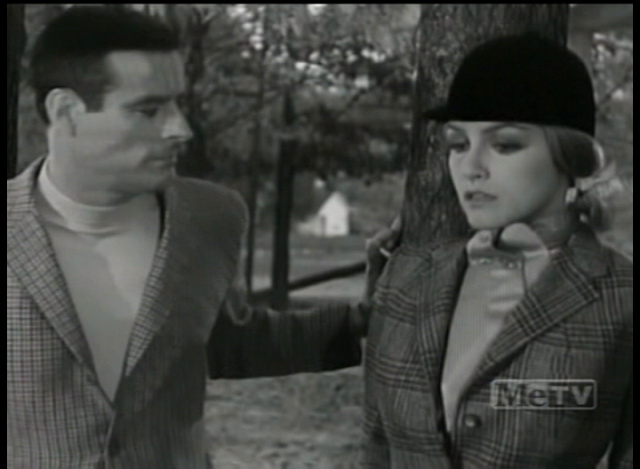
Robert Webber prepares to tell Julie Newmar where their relationship stands in
Give the Old Cat a Tender Mouse (aired Dec. 1962).
|
As long as we've gone this far, let's probe a little deeper into Route 66 by examining another
episode, "Give the Old Cat a Tender Mouse," which had appeared the year before with guest stars
Robert Webber (Frank) and Julie Newmar (Vicki) (no spanking for Julie, alas). Julie plays the
daughter of a wealthy family in the east who have decided she should be wed to the son
(Webber) of an even wealthier family in Memphis. Julie rides in on her motorcycle (this is supposed to
tell us that she's a free spirit) and boldly introduces herself to Webber, followed wherever she goes by her
family's agent, Pogo, driving a van. You can see that this bizarrerie is presented as if it were some kind of
interesting uniqueness, just as it was in "Come Out, Come Out, Wherever You Are" and many other episodes.
As for our stars, George Maharis was ailing and Martin Milner was reduced to providing alleged comic
relief by being stopped repeatedly by the same motorcycle cop when he literally chases after Vicki, whom
he had met in an earlier episode.
|
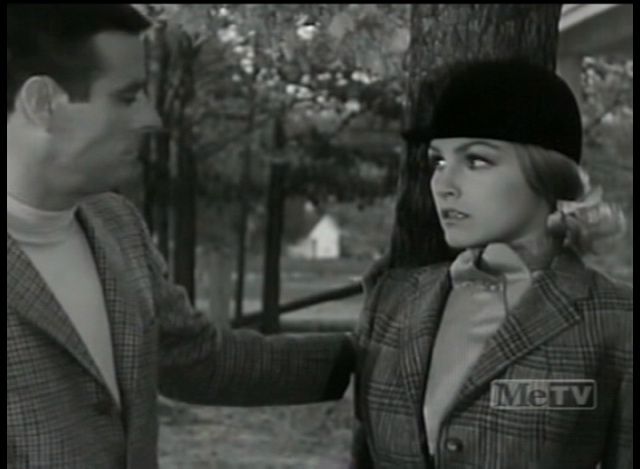
Julie with a concerned expression as she realizes that the news isn't good.
|
It's hard to describe the progress of their romance - they run around together a bit and seem to be
getting along o.k. although Vicki attracts so much male attention that Frank winds up in a fight.
Eventually, Frank takes her to his family's country estate where they go horseback riding and she
manages to jump a horse higher than he can. Apparently he's somewhat insecure because, as he says,
"All I want is a woman who is not a contender for the title."
Like everything else about this series, the final scene fails to convince once you start to think about
it even slightly.
|
|
|
Let's take a look at that final scene now. Note that not even the good performances from Julie and
Webber (who sustains an extremely long speech very well), and Nelson Riddle's original music (as
the scene begins to close) can turn it into something meaningful.
The player at left should work with most browsers, or you can download the
Windows Media (WMV) version here. No MPEG-2 version is
being provided, since we don't imagine anyone is interested in burning this scene to DVD.
To download, right-click and then select "Save Target As".
|
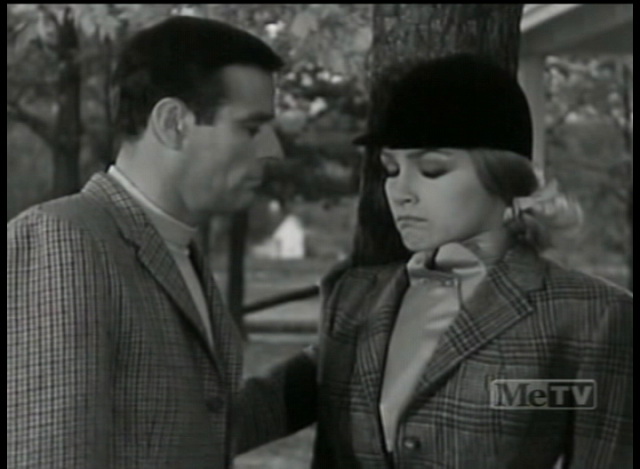
"Good-bye, Vicki." Robert Webber breaks up with Julie Newmar in Give the Old Cat a Tender Mouse.
It would be interesting to know the percentage of male viewers at the time who thought he was nuts!
|
It's really a shame the drama wasn't better on Route 66, because it turned out to be Nelson
Riddle's only chance to do some serious dramatic scoring and he would surely have risen to the occasion
had there been any real drama. He had been a successful arranger in the 1950's,
and after this series went on to do Batman, where he wrote a new theme for each guest
super-villain, including of course Julie's Catwoman. As for naturalism, television never really
abandoned it: the 70's were dominated mainly by melodrama with a naturalistic mode of presentation
(Kojak, etc.), giving way to pseudo-drama in the 80's (think Steven Bochco), and finally to the
dreadful uber-naturalism of today's "Reality TV".
Stirling Silliphant (1918 - 1996) never won an Emmy, nor did he deserve to as there were
contemporary series such as The Fugitive that offered better drama than Route 66.
(Our spankee Diane Baker guest-starred in the last episode of The Fugitive several years later,
by the way). Silliphant did go on to win the Best Screenplay Oscar for In the Heat of the Night
in 1967. While we think that film is overrated, he did manage to avoid making the same technical errors he
had throughout Route 66, and we have to wonder what he might have done had he actually taken the
time to refine his craft instead of just hacking out episode after episode.
|
